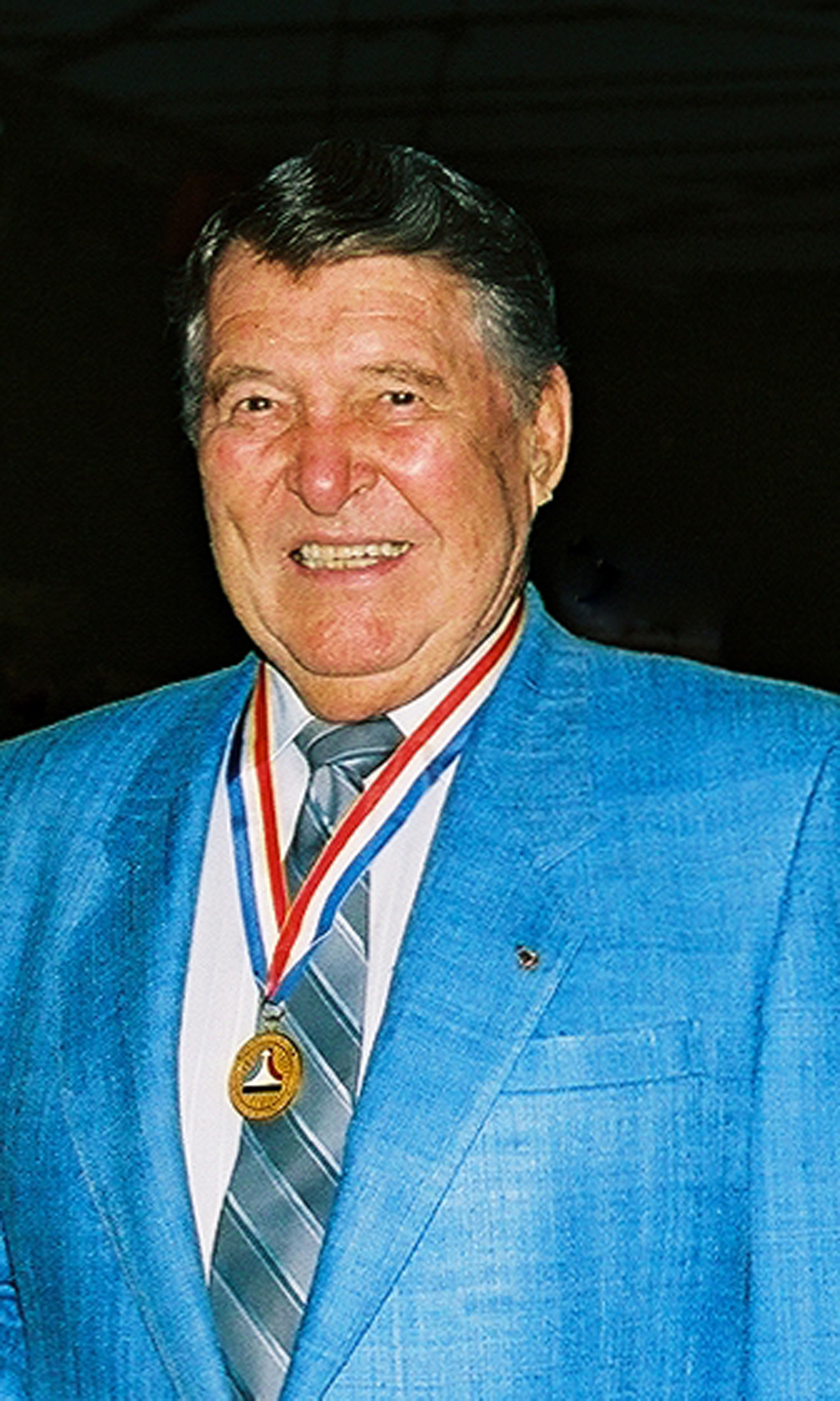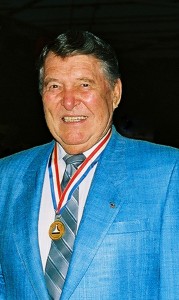|
By Clayton Moore
His famous frivolity may fall silent now, but the colorful life and legacy of Wally Schirra will remain forever in the hearts of Americans. The celebrated pilot, astronaut and most jolly member of the original seven Mercury astronauts died of a heart attack on May 3 at the age of 84. “It’s the terrible loss of a dear friend, cherished comrade and a brother,” said fellow Mercury astronaut Scott Carpenter. “Despite our good-natured competition for flights into space, Wally strove to bring a smile to everyone he met, and it’s with a smile that I will forever fondly remember him.” The passing of any astronaut, one of a brotherhood that includes so few, is a sad occasion, but Schirra’s passage prompts reflection on a legend even among other legendary pilots. Schirra, a lighthearted but deeply professional aviator who was well known as a “textbook” pilot, will remain in history books as the fifth American in space, but his feats reach well beyond that first space flight in 1962. A former fighter pilot in Korea, Schirra not only took part in the Mercury missions but also flew on the Gemini 6 mission in 1965 and commanded the Apollo 7 mission in 1968. He was the only astronaut to fly in all three of NASA’s original manned spaceflight programs. Among his fellow astronauts, he was famous for mercilessly mischievous pranks in the most crucial moments, but he also took his job seriously. The weight of his burdens was brought close to home with the Apollo 1 disaster. It was Schirra who helped the team deconstruct the accident and commanded the Apollo 7 mission to bring mankind back to space. “It was impossible to know Wally—even to meet him—without realizing at once that he was a man who relished the lighter side of life, the puns and jokes and pranks that can enliven a gathering,” said NASA Administrator Mike Griffin in an email to NASA employees. “But this was a distraction from the true nature of the man. His record as a pioneering space pilot shows the real stuff of which he was made. We who have inherited today’s space program will always be in his debt.” |
A pilot’s pilot
Walter M. “Wally” Schirra Jr. was a pilot born of pilots. A native of Hackensack, N.J., he was born on March 12, 1923, to Walter and Florence Leach Schirra. Walter Schirra Sr. was a World War I ace who later flew barnstorming stunts in air circuses, often accompanied by his wife, who performed wing-walking stunts.
Inspired by the popular flights of fancy immortalized by Buck Rogers and Flash Gordon, Schirra was long fascinated by flight. He learned to fly early, under his father’s instruction. During his first flight, at age 13, his father handed over the controls at 3,000 feet above Teterboro Airport in New Jersey.
After graduating from high school, he spent a year at the Newark College of Engineering before entering the U.S. Naval Academy at Annapolis, earning a BS in 1945. A lifetime Navy man, he served for a year prior to pilot training in Pensacola, Fla. He earned his wings in 1948.
He flew three years as a carrier pilot before entering an exchange program with the Air Force. Schirra flew 90 combat missions in Korea between 1951 and 1952, mostly in F-84s, and was credited with one confirmed kill of a MiG.
Returning to the states after the war, he helped develop the Sidewinder missile, while stationed at the Naval Ordinance Training Station at China Lake, Calif. He served another three-year tour with the 124th Fighter Squadron aboard the carrier Lexington before his selection for the Naval Test Pilot School at Patuxent River, Md., his last earth-bound duty before heading to higher altitudes.
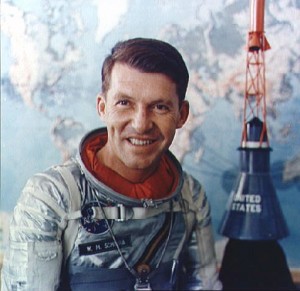
In a formal portrait from the 1960s, Wally Schirra, in his Mercury pressure suit, poses in front of a Mercury spacecraft model.
The “Original Seven”
In one of his biographies, Schirra admitted his desire to become “a hot shot test pilot—not just a scarf-and-goggles type, but one who could use his engineering confidence to work on systems and make the best airplane, ever.”
Schirra would soon surpass airplanes to fly higher than any earthbound pilot. Though he was initially reluctant to leave the Navy, Schirra was selected in April 1959 to become one of seven Mercury astronauts. He specialized in life support systems for the emergent spacecraft.
His sense of humor emerged early in the training process. When a nurse demanded he provide a urine sample, Schirra filled a five-gallon jug with warm water, detergent and iodine and left it on her desk.
“Levity makes life a lot easier,” he said. “Levity is the lubricant of a crisis. We resort to jokes, pranks and good-natured kidding to relieve tension, stress and boredom.”
Despite the flashbulb attention of the world’s press, Schirra’s down-to-earth humor remained intact. He recalled the day the “Original Seven” were introduced at a press conference.
“Here we are, looking around, somewhat awestricken ourselves,” he recalled. “I said, ‘My gosh! We’ve joined a whole new world! And we haven’t done a damn thing yet!'”
Schirra’s first spaceflight came on Oct. 3, 1962, during the Mercury-Atlas 8 mission. He named his spacecraft Sigma 7, symbolizing engineering precision. It was a perfect flight, during which he made six orbits of the Earth in 9 hours, 13 minutes.
“I’m having a ball up here drifting,” he said from his tiny capsule.
Staying true to his Navy roots, Schirra stayed aboard Sigma 7 until it was lifted to the deck of the carrier Kearsage.
“We shared a common dream to test the limits of man’s imagination and daring,” Schirra wrote of the Mercury Seven. “Those early pioneering flights of Mercury. established us once and for all as what I like to call a space-faring nation.”
In 1998, Schirra spoke once more of his teammates at Johnson Space Center, during a celebration of the life of the late Alan Shepard.
“The brotherhood we have will endure forever,” Schirra said.

Wally Schirra was one of seven pilots selected to be America’s first astronauts. L to R: Scott Carpenter, Gordon Cooper, John Glenn Jr., Virgil “Gus” Grissom Jr., Wally Schirra Jr., Alan Shepard Jr. and Donald “Deke” Slayton pose in front of an F-106B.
Of those seven astronauts, on whose broad shoulders the human race moved forward by leaps and bounds, only former U.S. Senator John Glenn and Scott Carpenter remain.
The real stuff
Schirra commanded Gemini 6 during his next spaceflight in December 1965. The complex mission demonstrated the easygoing pilot’s more serious side. On the first attempt to launch the spacecraft, the Titan booster shot enormous flames but failed to take off. With just seconds to decide, Schirra determined that the danger was minimal and elected not to pull the seat-ejection ring—a move that would’ve damaged the aircraft and blown the mission.
When Gemini launched three days later, his humorous side emerged again. In mid-flight, Schirra and crewmate Thomas Stafford rattled Mission Control with their deadpan report of a UFO resembling “a command module and eight smaller modules in front.”
“The pilot of the command module is wearing a red suit,” they reported.
As the ground team finally got their Santa Claus joke, Schirra and Stafford burst into a round of “Jingle Bells,” complete with a harmonica and sleigh bells that had been smuggled aboard.
Schirra kept spirits up during the in-flight rendezvous with Gemini 7. Pulling within a foot of his sister spacecraft, he held up a hand-lettered sign for Gemini 7’s command pilot, West Point graduate Frank Borman. In typical military heckling, the sign read, “Beat Army.”
Colleagues reported that Schirra became more serious following the death of three astronauts, including fellow Mercury pilot Virgil I. “Gus” Grissom, during the ill-fated Apollo 1 mission in January 1967.
“After the fire, he changed quite a bit,” recalled Gunter Wendt, a launch pad leader on Schirra’s missions. “He was always a happy-go-lucky guy, but now he knew he had to do better than that.”
As commander of the flight’s back-up crew, it was left to Schirra to help oversee the gutting of Apollo 1 and the redesign of the ship. He saw the subsequent Apollo 7 mission not as a scientific expedition but as an engineering flight—a shakedown flight, in the parlance of engineers. He challenged the chief executives of the spacecraft’s lead contractor.
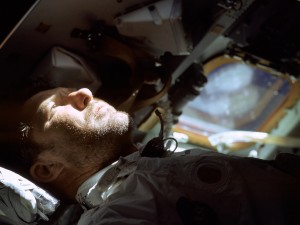
Wally Schirra looks out of the rendezvous window in front of the commander’s station during the Apollo 7 mission.
“You guys want to fix this ship or not?” Schirra asked. “If so, let me see you down on the factory floor with the rest of us.”
It wasn’t an easy time. Of space, Schirra once said, “Mostly it’s lousy out there.”
“It’s a hostile environment, and it’s trying to kill you,” he said. “The outside temperature goes from a minus 450 degrees to a plus 300 degrees. You sit in a flying thermos bottle.”
Add to that description the development that all three of its astronauts were suffering from vicious colds, and Apollo 7 added up to one miserable flight, on Oct. 11, 1968. With tensions rising between Schirra and Mission Control, mission director Chris Kraft broke protocol and proposed to speak to Schirra directly. Fellow astronaut Deke Slayton stepped in to moderate.
“I told (Schirra) that the whole world was following his flight, and that he and his crew weren’t coming across well,” Slayton told Kraft. “I told him that he was trained to do a job, and that he’d better get busy doing it.”
“And?” Kraft asked.
“And he told me to go to hell,” Slayton said.
Despite Schirra’s disagreeable mood, the flight was textbook perfect. It qualified the redesigned Apollo capsule for future flights to the moon and restored the nation’s confidence in the space program.
“At times, he gave us a hard time during his flight; technically what he did was superb,” Kraft said. “On Mercury, Gemini and Apollo, he flew all three and didn’t make a mistake. He was a consummate test pilot. The job he did on all three was superb.”
Life on Earth
During his career with NASA, Schirra logged more than 295 hours in space during three flights. His military awards included the Navy Distinguished Service Medal, three Distinguished Flying Crosses, three Air Medals, two NASA Distinguished Service Medals and the NASA Exceptional Service Medal.
Since entering the military, the famous pilot had also raised a son, Walter III, and a daughter, Suzanne, with his wife Josephine. Having more than fulfilled his duty to his country, on July 1, 1969, Schirra resigned from NASA, retiring as captain from the Navy.
“I’ve been gone a heck of a lot,” Schirra said of his decision to retire. “It takes a lot out of you.”
He joined CBS News as a consultant and worked with newsman Walter Cronkite to cover the historic moonwalk of Buzz Aldrin and Neil Armstrong. He stressed that just getting to the moon wasn’t the point.
“Moon and back,” he would emphasize. “We did confirm a round trip from the very beginning. ‘Moonandback’ is one word. No hyphens. No commas.”
On July 21, 1969, nearly in tears, Schirra provided narration of the mission until his fellow astronauts set foot on the moon.
“It’s an urge—a pioneering urge,” Schirra said in a later interview. “We feel very uplifted by exploration, and I think that’s probably what made us want to go to the moon.”
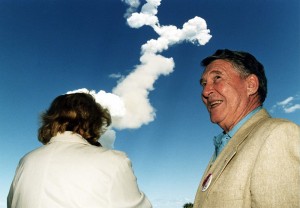
Wally Schirra and wife Josephine were among NASA’s special guests to watch the liftoff of the Space Shuttle Columbia on April 4, 1997.
In later years, Schirra became president of Regency Investors, a financial company based in Denver, and served as national spokesman for several organizations and companies. He wrote or collaborated on three books. “We Seven” was published in 1960, “Schirra’s Space” in 1988 and “The Real Space Cowboys” in 2005. Along the way, he was awarded honorary doctorates by various institutions.
In 1984, he helped found the Mercury Seven Foundation (now the Astronaut Scholarship Foundation), which creates college scholarships for science and engineering students. Schirra was also active in several other nonprofit organizations including the Oceans Foundation, the Advisory Board of U.S. National Parks, the San Diego Aerospace Museum, the Scripps Aquarium and the International Council of the Salk Institute.
In 1984, he moved to Rancho Santa Fe, a San Diego suburb, where he served on corporate boards and worked occasionally as an independent consultant under the auspices of his own company, Schirra Enterprises. He traded in his spacecraft for a more sedate mode of transport, a 36-foot sailboat christened Windchime, and enjoyed skiing, hunting, fishing and yachting.
He was enshrined in the National Aviation Hall of Fame in 1986 and inducted into the U.S. Astronaut Hall of Fame in 1990, followed by induction into the Naval Aviation Hall of Honor in 2000. In 2005, he was named a NASA Ambassador of Exploration and presented with a moon rock by Capt. Eugene Cernan, Apollo 17 commander.
Schirra, who had been diagnosed with cancer, died at Scripps Green Hospital in La Jolla, Calif. President George W. Bush expressed the nation’s regrets in a statement.
“His ventures into space furthered our understanding of manned space flight and helped pave the way for mankind’s first journey to the moon,” he said. “Laura and I join Wally’s family and friends and the NASA community in mourning the loss of an American hero.”
In one of his final interviews, given to the Associated Press last month, Schirra bid an insightful, whimsical farewell to those he left behind.
“I left Earth three times,” Schirra said. “I found no place else to go. Please take care of Spaceship Earth.”











